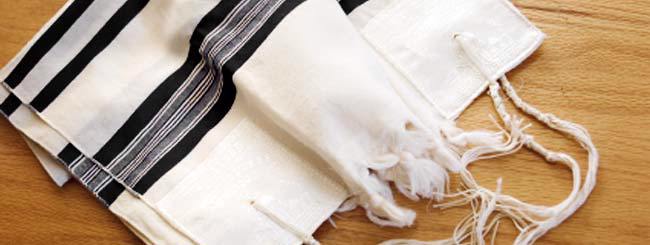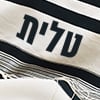What Is a Tallit?
A tallit (טַלִּית) is a Jewish prayer shawl. As per the Bible’s instructions, the rectangular tallit has fringes attached to each of its four corners. These serve to remind the Jew of G‑d and His commandments.
The tallit, ideally made of wool (read why, here), is most often white, with black stripes running down two sides of the garment (read why, here). Called tzitzit (or tzitzis) (צִיצִית) in Hebrew, each fringe is made of four strands looped over to make eight strands in total.
The tallit is draped over the shoulders like a cape, with two corners at the front of the wearer, and two at the back.
Tallit: Who and When
Technically, the tallit should be worn all day, but that is not practical in today’s world. And so, another garment developed: the poncho-like garment that is worn under street clothing all day long. This garment is most commonly known as tzitzit, but is also referred to as arba kanfot (“four corners”), or tallit katan (“small tallit”).
The tallit is still worn during morning prayers (along with tefillin, which Jewish men wear on weekdays from the age of 13). The tallit is worn all day on Yom Kippur, and in many communities, the chazzan (prayer leader) wears the tallit during other services as well.
In Eastern European Ashkenazic communities, boys wear the tallit katan from as young as three years old but only begin wearing the tallit gadol, the “large tallit,” regularly after marriage. Sephardic and Western Europeans, however, begin wearing it much earlier. (Read more here.)
Only men are obligated to wear the tallit. (Read more here.)
Tekhelet: The Mystery of the Blue Thread
In ancient times, the tallit would have two kinds of threads attached to the corners, white wool (or whatever the garment was made of) and blue wool. This blue wool, known as tekhelet, was the hallmark of nobility, and in line with the tallit’s purpose of reminding the Jew that he is a member of G‑d’s “kingdom of priests.”
The unique blue dye was made from a byproduct of a sea creature known as the chilazon, which lives in the Mediterranean Sea. However, during the Talmudic era, as the center of Jewish life shifted away from the Mediterranean Sea, and tekhelet was heavily taxed or even outlawed, it became rarer and rarer, and eventually disappeared entirely from the tallit.
In recent years, there has been much speculation regarding the identity of the chilazon and the possibility of reintroducing tekhelet. Read more about that here.
Tallit in the Bible
The Torah commands us twice regarding affixing fringes to our garments.1
First G‑d tells Moses to command the children of Israel to
Make for themselves fringes on the corners of their garments, throughout their generations, and they shall affix a thread of tekhelet on the fringe of each corner.
G‑d then specifies the reason why we should wear the fringes:
This shall be fringes for you, and when you see it, you will remember all the commandments of the L‑rd to perform them, and you shall not wander after your hearts and after your eyes after which you are going astray. So that you shall remember and perform all My commandments and you shall be holy to your G‑d. I am the L‑rd, your G‑d, Who took you out of the land of Egypt to be your G‑d; I am the L‑rd, your G‑d.
Later, we read, “You shall make yourself twisted threads, on the four corners of your garment with which you cover yourself.”2
How the Tallit Serves as a Reminder
The strings and knots of the tallit are a physical representation of the Torah's 613 mitzvahs. It works like this: Each letter in the Hebrew alphabet has a corresponding numerical value (gematria). The numerical values of the five letters that comprise the Hebrew word tzitzit add up to 600. Add the eight strings and five knots of each tassel, and the total is 613 (600+5+8=613).
Wearing tzitzit is a sign of Jewish pride. Jews always had a way of dress that distinguished them from the people of the lands in which they lived—even when that meant exposing themselves to danger and bigotry. By the grace of G‑d, today most of us live in lands where we are free to practice our religion without such fears. Today we wear our Jewish uniform with pride and with our heads held high.
Kabbalah teaches that the tallit garment, which wraps around us, is a metaphor for G‑d's infinite transcendent light. The fringes allude to the immanent Divine light, which extends into and permeates every element of creation. By wearing a tallit gadol or a tallit katan, a Jew synthesizes these two elements and makes them real in his life.
Purchasing a Tallit
"This is my G‑d and I will beautify Him."3 We "beautify" G‑d by performing His commandments in a beautiful fashion. This includes spending the extra dollar to purchase high-quality tallit and tzitzit. Some (not Chabad) also have the custom of adorning the tallit's headpiece with a silver atarah ("crown").
Today, there are plenty of artfully-decorated designer talittot, most of which are acceptable according to Jewish law. Because there are many laws involved in the making of a tallit and tzitzit, they should always be purchased from a G‑d-fearing and trustworthy vendor.
Be sure the tallit is made of wool and is large enough to cover most of your body.













Join the Discussion